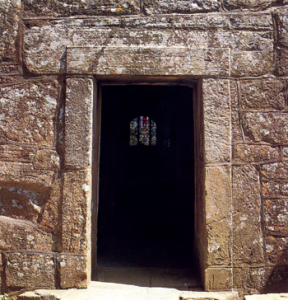Tuamgraney church
Published in Gems of Architecture, Issue 2 (March/April 2014), Volume 22
The doorway is one of the finest examples from early medieval Ireland. (Jacqueline O’Brien)
Of any extant building, the church at Tuamgraney, Co. Clare, is arguably the one that provides us with our most tan-gible link to Brian Boru. Tuamgraney was one of the most significant ecclesiastical sites in the home territory of the Dál Cais. The western part of the church is pre-Romanesque, and it is generally agreed that it must be the great church (teampull mór) built by Cormac Ua Cillín, coarb of Tuamgraney, who died in 966 (Chronicon Scottorum).
Perhaps it was the materials used to build the church that led the annalist to describe it as ‘great’, for mortared stone construction was very unusual in mid-tenth-century Ireland. The vast majority of churches were still of wood and the influence of this carpentry tradition is evident in early mortared churches. The antae projecting from the corners of Tuamgraney church are usually interpreted as skeuomorphs: translations into stone of features found in wooden churches. Originally, they would have supported wooden end-rafters, taking the roof structure beyond the stone gables. The present roof terminates at the interior of the gables, so the antae to either side of the doorway now seem superfluous and forlorn. The doorway is one of the finest examples from early medieval Ireland. At the exterior is a plain architrave in relief, which may well have been intended to recall a wooden doorframe. There is a wonderful contrast between the slightly irregular shapes of the blocks on the one hand and the precision with which they have been carved and fitted to produce the doorway and architrave on the other. The east window was removed when the Romanesque extension was added but the original south window survives, though it has been rebuilt. It too features a plain relief architrave: the only surviving example from any pre-Romanesque window in Ireland.
Tuamgraney was founded by Crónán, an Uí Fhiachrach Aidne saint. Though based in south Galway, this group supplied the majority of Tuamgraney’s coarbs, including Cormac Ua Cillín. Donnchadh Ó Corráin has pointed out that the persistence of this tradition must have been part of a Dál Cais strategy to strengthen their links with their Uí Fhiachrach Aidne allies. Brian’s first wife, Mór, was of this group. The 966 entry states that Cormac also built a round tower at Tuamgraney, though this does not survive. The early twelfth-century Cogadh Gáedhel re Gallaibh claims that this round tower was built with the involvement of Brian Boru. This is probably fabrication, for he did not become king until 976, at least a decade after it was built, while the Cogadh implies that it was built in 1012. Given the local importance of the site, however, there can be little doubt that Brian was familiar with the tower and that he entered the church.
As Ó Corráin has shown, one of the ways in which Brian and his son Donnchadh consolidated and extended their authority in Dál Cais and beyond was to place relatives in charge of important ecclesiastical sites, including Killaloe, Iniscealtra, Terryglass, Lorrha and Scattery Island. Interestingly, within this region these sites tend to be the ones with relatively early stone churches and round towers. While the evidence is often circumstantial, taken as a whole the pattern suggests that commissioning such buildings was an important part of the Dál Cais strategy to cement their association with these sites and with the cults of their founding saints. If so, one wonders whether it was the church and round tower at Tuamgraney, possibly the first of their kind in Dál Cais, that provided Brian with a template for the elaboration of other ecclesiastical sites that were of strategic importance to him.
Tomás Ó Carragáin lectures in archaeology at University College Cork.
Further reading
G. Madden, A history of Tuamgraney and Scarriff since earliest times (Tuamgraney, 2000).
T. Ó Carragáin, Churches in early medieval Ireland: architecture, ritual and memory (New Haven, 2010).
D. Ó Corráin, ‘Dáil Cais: church and dynasty’, Ériu 24 (1973), 52–63.
















